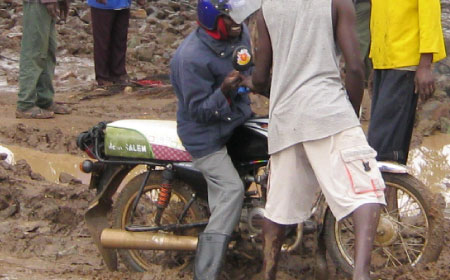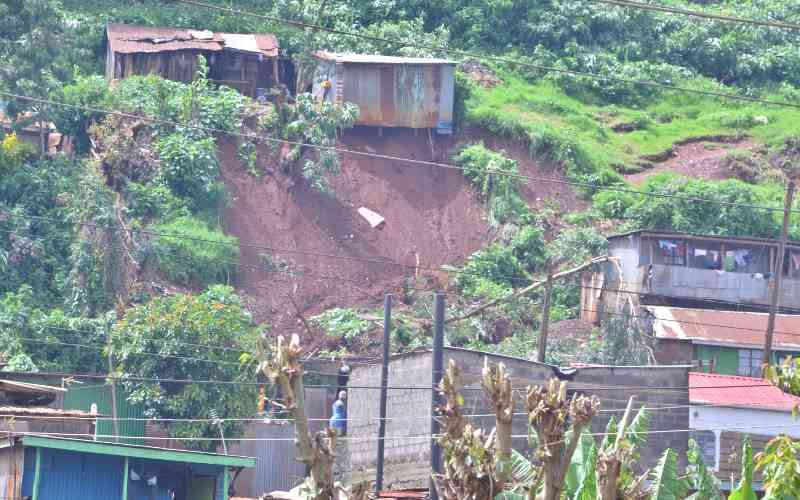 |
|
After River Suam changed course, residents constructed a makeshift road with stones to allow passage. They hope next year’s incoming county government will improve the roads. [Photo: Jeckonia Otieno/Standard] |
By Jeckonia Otieno
Rainy seasons complicate life for the people of Kacheliba and Kongelai in Kacheliba and Kapenguria constituencies respectively. The two areas share more than a boundary; they have a symbiotic relationship and peace. But when it rains, this relationship is disrupted.
Under normal circumstances, this area is dry. So when it rains, it pours as if to make up for the many months of drought.
It is at such times that the narrow bridge that links the two constituencies over River Suam is washed away or becomes useless. Without the use of this vital bridge, life in Kacheliba and Kongelai is disrupted.
While the people of Kongelai have their district headquarters in Kapenguria some 40km away, they rely on Kacheliba District Hospital just across the bridge, just a kilometre away.
Rely on market
On the same note, while the people of Kacheliba might boast of the hospital, they rely on the market at Kongelai just beside the bridge to sell their goods and services.
It is because of this symbiotic relationship between the two constituencies that the people are able to co-exist. Otherwise, they are deadly enemies when it comes to fighting over pasture for their animals, especially during the lengthy dry spells.
The rains pounding the area since mid-April have made grass grow and provided sufficient water for the animals, but with it soil has been extensively eroded and River Suam has changed its course.
It now flows just before the main bridge. With this change, the people cannot cross to the neighbouring constituency to transact their normal business.
So one morning, some people decided to make a passage by picking stones from the river’s bank to fill the trench. Soon another group arrives arguing that the stones being used were actually meant for sale.
“But where will the lorries pass to pick these stones?” one of the young men filling the gulley with stones asks the other group.
As they argue, people wishing to cross from one side to the other are getting impatient. They don’t know where to direct their anger.
Some decide it is the Government’s fault that their normal functions have been disrupted. They say the Government which is supposed to provide roads to all Kenyans has ignored their plight.
Luke Chemukot, a matatu driver says every time the rains come down he and other matatu operators are forced to cancel their services because no vehicle can cross the bridge; the swivelling waters can sweep it away.
Chemukot laments, “Which Kenya are we living in? I think we are better off in Uganda which has better roads yet it is only a few kilometres away. I can never be proud to be called a Kenyan because the government has forgotten us!”
Stay informed. Subscribe to our newsletter
Endured torture
Mama Selina Kaparlai is a regular traveller on this route and she says for a long time she and others have endured the torture that the rain brings with it, that when the river breaks its banks then it takes hours for people to cross.
“At my age I cannot swim just like these young people do. If I slip into the river then I will be washed away,” says Kaparlai.
Like Karalpai, many others live at the mercy of the river and nature. Locals say that whenever it rains, all activities come to a standstill because nothing can help them cross the point where it breaks its bank.
Chemukot says he has seen people die when the river is swollen just because they cannot cross. And to complicate matters for the locals, medical emergencies are “not allowed” during the rainy season, says a nurse at Kacheliba Hospital.
End up dying
She has worked at the hospital for years and has seen people who could have been saved if they arrived in hospital earlier end up dying. With emergency services, such tragic end could be avoided, she says.
Residents describe an incident when two vehicles, a lorry belonging to a soft drink company and a matatu carrying passengers from Kapenguria, almost plunged into the huge gully recently. The rains had just washed away the ground.
The ministry of Local Government has embarked on a plan to build a terrace by the riverbank but locals say it is too little too late because the work is progressing slowly and won’t be finished before the rainy season ends.
They say they don’t want such short-term measure but a long-term solution.
Says Renson Apakamori: “We need a long lasting solution because a number of people have lost their lives while attempting to cross the river over the years. Apakamori is the one coordinating the temporary stone filling measure.
To make the road passable, the youths cut three trees in minutes using a power saw and quickly but haphazardly arrange the stones to ensure an easy flow of traffic over the muddy patch that is slowly turning into a river valley.
“If we keep waiting for government to solve this problem then we might wait for ever. That is why we took it upon ourselves to do something to salvage the situation,” says Apakamori.
 The Standard Group Plc is a
multi-media organization with investments in media platforms spanning newspaper
print operations, television, radio broadcasting, digital and online services. The
Standard Group is recognized as a leading multi-media house in Kenya with a key
influence in matters of national and international interest.
The Standard Group Plc is a
multi-media organization with investments in media platforms spanning newspaper
print operations, television, radio broadcasting, digital and online services. The
Standard Group is recognized as a leading multi-media house in Kenya with a key
influence in matters of national and international interest.
 The Standard Group Plc is a
multi-media organization with investments in media platforms spanning newspaper
print operations, television, radio broadcasting, digital and online services. The
Standard Group is recognized as a leading multi-media house in Kenya with a key
influence in matters of national and international interest.
The Standard Group Plc is a
multi-media organization with investments in media platforms spanning newspaper
print operations, television, radio broadcasting, digital and online services. The
Standard Group is recognized as a leading multi-media house in Kenya with a key
influence in matters of national and international interest.









